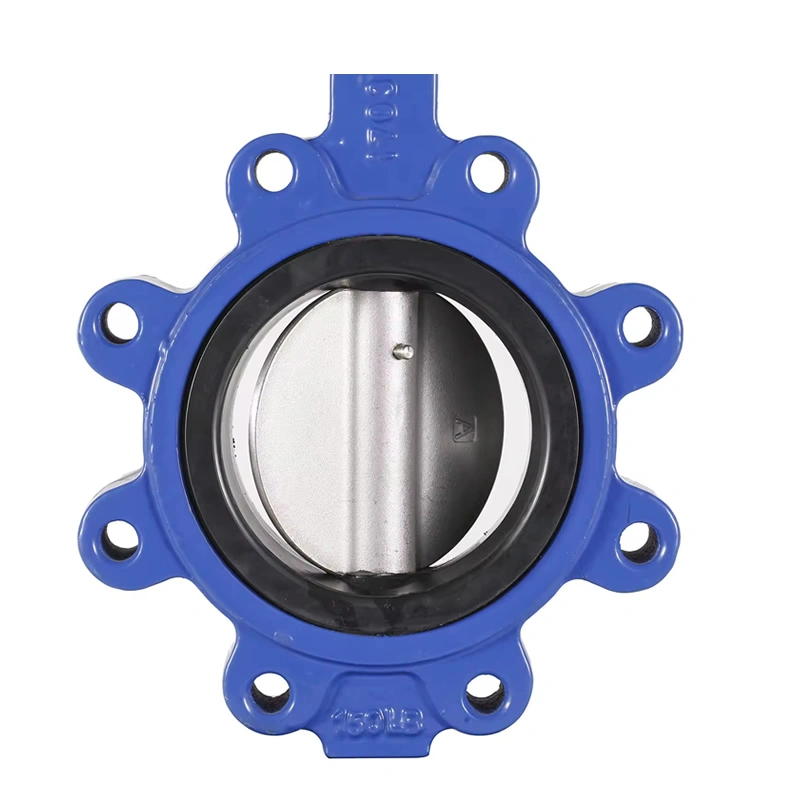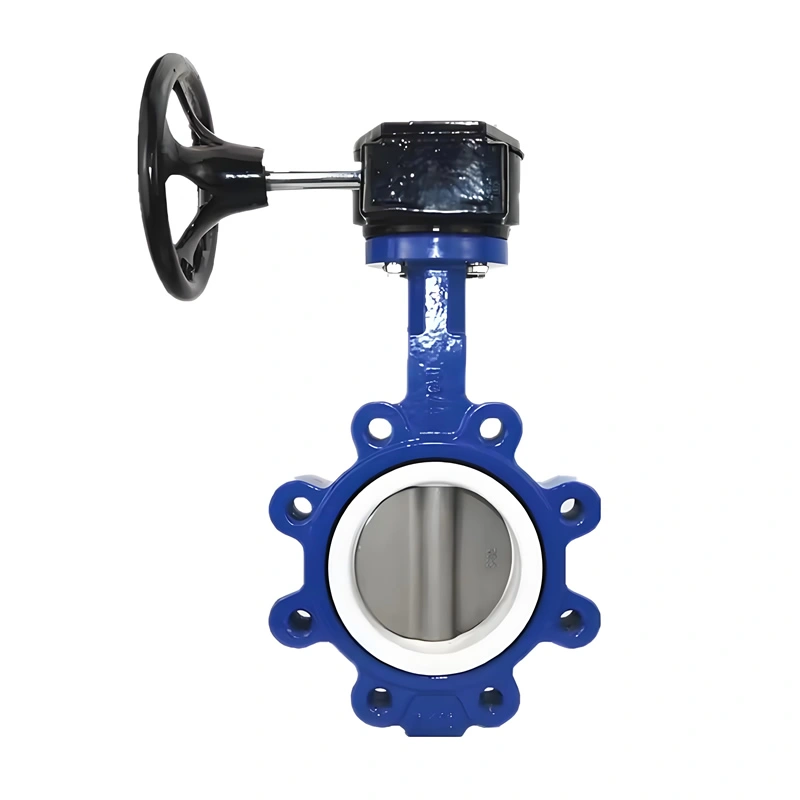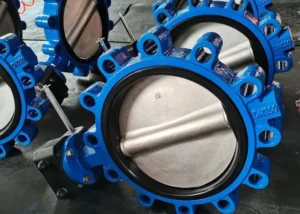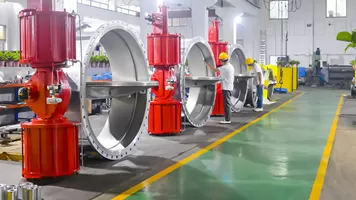Potable water systems—spanning municipal distribution networks, water treatment plants, commercial buildings, and residential complexes—demand the highest standards of safety, reliability, and purity. Every component in these systems, from pipes to valves, must prevent contamination, resist corrosion, and maintain long-term performance to protect public health. Among the critical components, butterfly valves with EPDM (Ethylene Propylene Diene Monomer) liners have emerged as the gold standard for potable water applications, combining cost-effectiveness, ease of operation, and strict compliance with global safety regulations.
EPDM liners act as a barrier between the valve’s metal components (typically ductile iron or stainless steel) and the water, preventing leaching of heavy metals, rust, or other contaminants. In a sector where even trace amounts of harmful substances—such as lead exceeding 0.01 mg/L or BPA above 0.1 μg/L—can trigger regulatory violations and public health risks, EPDM’s inertness and durability make it indispensable. A properly designed EPDM-lined Butterfly Valve can operate for 15–20 years with minimal maintenance, reducing lifecycle costs by 40% compared to unlined or alternative-lined valves.
This article explores the technical interplay between EPDM liners and butterfly valve design, the critical compliance standards governing potable water applications, performance metrics, real-world applications, and why TIANYU’s EPDM-lined Butterfly Valves set the benchmark for safety and reliability in drinking water systems.

I. Why EPDM? Material Properties for Potable Water Safety
EPDM is a synthetic rubber engineered for exceptional chemical resistance, elasticity, and longevity—properties that align perfectly with the demands of potable water systems. Its suitability stems from a unique combination of physical and chemical characteristics, rigorously tested to ensure it meets global safety standards for drinking water contact.
A. Chemical Inertness and Contamination Prevention
Potable water systems use disinfectants like chlorine (0.5–4 mg/L residual) and chloramines to kill bacteria, creating a mildly aggressive environment. EPDM’s chemical structure—composed of ethylene, propylene, and a small amount of diene monomer—resists degradation from these disinfectants, as well as from pH fluctuations (typically 6.5–8.5 in drinking water).
- Extractable Limits: Under NSF/ANSI 61 testing (the global standard for drinking water system components), EPDM liners leach <0.5 mg/L of total organic compounds and <0.001 mg/L of heavy metals (lead, cadmium, mercury)—well below regulatory thresholds.
- Chlorine Resistance: EPDM retains 90% of its tensile strength after 10,000 hours of exposure to 5 mg/L free chlorine at 25°C, outperforming alternatives like natural rubber (50% strength retention) or neoprene (65%).
This inertness ensures no off-flavors, odors, or toxic substances migrate into the water, preserving its potability from treatment plant to tap.
B. Elasticity and Sealing Performance
Butterfly valves rely on a tight seal between the rotating disc and the valve body to prevent leakage. EPDM’s high elasticity (elongation at break >300%) allows it to conform to the disc’s surface, even with minor dimensional variations, ensuring bubble-tight shutoff.
- Seal Integrity: EPDM-lined butterfly valves achieve ANSI Class VI leakage rates (<0.0001% of full flow) when properly installed, meaning a DN100 valve (flow rate 300 GPM) leaks <0.0003 GPM—negligible for potable water systems.
- Compression Set Resistance: After 70 hours at 150°C (a standard test for long-term seal performance), EPDM exhibits <25% compression set, ensuring the seal remains effective over decades of use. Natural rubber, by comparison, shows >50% compression set under the same conditions, leading to premature leakage.
C. Temperature and Pressure Tolerance
Potable water systems operate across a range of temperatures (4°C to 60°C for hot water in commercial buildings) and pressures (typically 2–8 bar, with peaks up to 16 bar in municipal mains). EPDM-lined valves are engineered to perform reliably within these ranges:
- Temperature Range: EPDM remains flexible from -40°C to 120°C, avoiding brittleness in cold water or softening in hot water applications.
- Pressure Rating: EPDM liners, when properly bonded to ductile iron or stainless steel bodies, support pressure ratings up to PN16 (16 bar), suitable for most municipal and commercial potable water systems.
D. Durability and Lifespan
In potable water applications, valve replacement is costly and disruptive—often requiring system shutdowns and excavation in municipal networks. EPDM’s resistance to oxidation, ozone, and UV radiation (critical for outdoor installations) extends valve life:
- Service Life: EPDM-lined butterfly valves typically last 15–20 years in potable water service, compared to 8–12 years for valves with nitrile or natural rubber liners.
- Cycle Resistance: They withstand 100,000+ open-close cycles without liner degradation, making them ideal for systems requiring frequent operation (e.g., water treatment plants, commercial buildings with variable demand).
II. Butterfly Valve Design: Integrating EPDM Liners for Potable Water
The performance of an EPDM-lined butterfly valve depends not just on the liner material, but on how it integrates with the valve’s body, disc, and actuation system. Design engineers must balance liner thickness, bonding strength, and flow dynamics to ensure compliance, durability, and efficient operation.
A. Liner Configuration: Full vs. Partial Lining
EPDM liners are applied in two primary configurations, each suited to specific potable water applications:
- Full Lining: The entire internal surface of the valve body—including the flow path, flange faces, and seat area—is covered with EPDM (thickness 3–5 mm). This configuration eliminates all metal-to-water contact, critical for systems where the valve body is made of carbon steel or uncoated ductile iron (which could leach iron or rust). Full-lined valves are standard in municipal distribution networks and drinking water storage facilities.
- Partial Lining: Only the seat area and disc are lined with EPDM, while the body (typically 316L stainless steel) remains exposed. This is used in high-purity applications (e.g., pharmaceutical water systems) where the body material itself is corrosion-resistant and compliant, reducing weight and cost while maintaining seal integrity.
B. Liner Bonding: Ensuring Long-Term Adhesion
A liner that delaminates from the valve body can contaminate water, block flow, or cause leakage. To prevent this, EPDM liners are bonded to the valve body using specialized adhesives and curing processes:

- Surface Preparation: The valve body is sandblasted to a roughness of Ra 50–80 μm, creating a textured surface for the adhesive to grip. This increases bond strength by 60% compared to smooth surfaces.
- Adhesive Selection: Food-grade, water-resistant adhesives (compliant with FDA 21 CFR 175.105) are used, cured at 120–150°C for 30–60 minutes. This results in a bond strength of ≥5 N/mm²—strong enough to withstand pressure surges and thermal cycling.
- Quality Testing: Random samples undergo peel tests, where a 25 mm wide strip of liner is pulled away from the body. Failure must occur within the EPDM material itself (cohesive failure), not at the adhesive interface (adhesive failure), ensuring the bond remains intact.
C. Disc and Seat Design: Optimizing Flow and Seal
The disc and seat are the heart of the butterfly valve, and their design directly impacts flow efficiency and sealing:
- Disc Profile: EPDM-lined discs are aerodynamically shaped to minimize pressure drop (flow resistance coefficient ζ <0.6 for full-port valves). A DN100 full-lined valve with a contoured disc creates <0.5 bar pressure drop at 300 GPM, reducing pump energy use by 15% compared to valves with blunt discs.
- Seat Geometry: The seat (integral to the EPDM liner) features a “lip” design that compresses against the disc when closed, enhancing seal tightness. The lip thickness (1.5–2 mm) is calibrated to balance flexibility (for tight sealing) and durability (to resist wear during cycling).
D. Actuation Systems: Compatibility with Potable Water Environments
Actuators—manual, pneumatic, or electric—must be designed to avoid contaminating the water or degrading the EPDM liner:
- Manual Actuators: Handwheels or levers are made of corrosion-resistant materials (304 stainless steel, powder-coated aluminum) to prevent rust from entering the valve. Greases used in stem bearings are food-grade (NSF H1) to avoid leaching hydrocarbons.
- Pneumatic Actuators: For automated systems, pneumatic actuators use oil-free air (ISO 8573-1 Class 1.4.1) to prevent oil contamination of the liner. Diaphragms are EPDM or PTFE, compatible with the liner material.
- Electric Actuators: Sealed to IP67 standards to prevent water ingress, with stainless steel shafts and food-grade lubricants. They consume <10 W in standby mode, aligning with energy efficiency goals in municipal systems.
III. Compliance Standards for Potable Water Valves
Potable water systems are governed by stringent regulations worldwide, ensuring that all components—including EPDM-lined butterfly valves—pose no risk to public health. Compliance is not optional; non-compliant valves can lead to fines (up to $10,000 per day in the U.S. under the Safe Drinking Water Act) and reputational damage.
A. NSF/ANSI 61: Drinking Water System Components
NSF/ANSI 61 is the most widely recognized standard, setting limits for contaminants that can leach from components into drinking water. Key requirements for EPDM-lined valves include:
- Extractable Testing: Valves are immersed in test water (simulating potable water chemistry) at 23°C and 80°C for 7 days. Extracts are analyzed for:
- Heavy metals (lead ≤0.1 mg/L, cadmium ≤0.01 mg/L, arsenic ≤0.005 mg/L).
- Organic compounds (total trihalomethanes ≤0.1 mg/L, BPA ≤0.1 μg/L).
- Biological contaminants (no bacterial growth).
- Material Qualification: EPDM compounds must meet NSF/ANSI 51 (food contact) requirements, ensuring they contain no toxic additives (e.g., phthalates, heavy metal stabilizers).
B. FDA 21 CFR 177: Food Contact Materials
In the U.S., the FDA regulates materials in contact with potable water under 21 CFR 177, which includes:
- Allowable Polymers: EPDM is listed as a safe polymer, provided it meets monomer residue limits (ethylene ≤500 ppm, propylene ≤500 ppm).
- Additive Restrictions: Antioxidants, plasticizers, and fillers in EPDM must be FDA-approved (e.g., 受阻酚类抗氧化剂 instead of heavy metal-based alternatives).
C. WRAS Approval (UK and Europe)
The Water Regulations Advisory Scheme (WRAS) certifies products for use in UK water systems, with strict testing for:
- Taste and Odor: EPDM-lined valves must not impart detectable taste or odor to water, as judged by a panel of trained testers.
- Biofilm Resistance: The liner must resist bacterial growth (≤10 CFU/cm² after 30 days of static water exposure) to prevent microbial contamination.
D. Local Standards: Examples from Key Markets
- EU: Compliance with Regulation (EU) 10/2011, which sets migration limits for plastics in contact with food (and by extension, potable water). EPDM must migrate <0.01 mg/kg of restricted substances.
- Australia: AS/NZS 4020, which mirrors NSF/ANSI 61 but includes additional testing for fluoride resistance (critical in Australian water systems, where fluoride levels reach 1.5 mg/L).
- China: GB/T 17219, which specifies hygiene requirements for materials in contact with drinking water, including heavy metal limits and bacterial testing.
IV. Applications: Where EPDM-Lined Butterfly Valves Excel
EPDM-lined butterfly valves are versatile enough to serve in every segment of potable water systems, from treatment to distribution to end-use. Their combination of compliance, durability, and cost-effectiveness makes them the preferred choice in the following applications:

A. Municipal Water Distribution
Municipal networks transport water from treatment plants to homes and businesses, operating at 2–8 bar and requiring valves that resist corrosion and chlorine.
- Typical Sizes: DN100–DN600 (4”–24”), with larger valves (DN800–DN1200) used in trunk mains.
- Key Requirements: Full EPDM lining (to protect ductile iron bodies from rust), WRAS/NSF 61 compliance, and 100,000+ cycle life.
- Performance Data: A municipal network in Texas using DN300 EPDM-lined valves reported 99.9% uptime over 10 years, with zero contamination incidents and leakage rates <0.001% of flow.
B. Water Treatment Plants
Treatment plants use valves to control flow through filtration, disinfection, and storage processes, often with frequent cycling and exposure to disinfectants.
- Applications: Controlling flow to sand filters, chlorination tanks, and clear wells.
- Key Features: Automated electric actuators (for remote operation), full lining (to resist chlorine), and low pressure drop (ζ <0.5) to reduce pump energy.
- Case Study: A treatment plant in Florida replaced rubber-lined gate valves with DN200 EPDM-lined butterfly valves, cutting energy use by 18% (due to lower pressure drop) and reducing maintenance costs by $25,000/year.
C. Commercial and Institutional Buildings
Schools, hospitals, and office buildings require valves for domestic water, hot water, and irrigation systems, with a focus on safety and low maintenance.
- Typical Sizes: DN50–DN200 (2”–8”), with manual or pneumatic actuation.
- Key Requirements: NSF 61/FDA compliance (to protect occupants), EPDM resistance to hot water (up to 60°C), and quiet operation (no water hammer).
- Example: A 500-bed hospital in California installed DN100 EPDM-lined valves in its hot water loop, achieving 15 years of service with no leaks or contamination, meeting Joint Commission healthcare standards.
D. Residential Developments
Large residential complexes use valves to control water distribution to homes, with a focus on cost and reliability.
- Applications: Main isolation valves, sub-metering stations, and irrigation systems.
- Key Features: Compact design (wafer-style to save space), manual actuation (low cost), and UV-resistant EPDM (for outdoor installations).
- Data: A 1,000-home development in Arizona used DN150 EPDM-lined valves, reducing installation costs by 30% compared to stainless steel ball valves and requiring no maintenance for 8 years.
V. Performance Testing: Validating Compliance and Reliability
EPDM-lined butterfly valves for potable water undergo rigorous testing to ensure they meet compliance standards and perform reliably over their lifespan. Testing covers material safety, structural integrity, and operational durability.
A. Material Safety Testing
- Extractables Analysis: Per NSF/ANSI 61, valves are tested in simulated potable water (pH 6.5–8.5, 25°C and 80°C) for 7 days. Extracts are analyzed via ICP-MS (for heavy metals) and GC-MS (for organics), ensuring all contaminants are below regulatory limits.
- Taste and Odor Testing: A panel of 10 trained testers evaluates water exposed to the valve for 72 hours, rating taste and odor on a 0–5 scale (0 = no detectable impact). A passing score requires all testers to rate ≤1.
B. Structural and Seal Testing
- Hydrostatic Pressure Test: Valves are pressurized to 1.5× their rated pressure (e.g., 24 bar for PN16) for 30 minutes, with no leakage from the body or flanges.
- Seat Leakage Test: With the valve closed, 1.1× rated pressure is applied to one side, and leakage from the other side is measured. ANSI Class VI requires <0.0001% of full flow—for a DN100 valve, this means <0.0003 GPM.
C. Durability Testing
- Cycle Testing: Valves undergo 100,000 open-close cycles at 10 cycles per minute, with pressure maintained at 70% of rated pressure. Post-test, leakage must remain within Class VI limits, and the liner must show no signs of delamination or wear.
- Aging Test: EPDM liners are exposed to 5 mg/L chlorine at 40°C for 12 months (accelerated aging). Tensile strength and elongation must remain ≥80% of original values, ensuring long-term performance.
VI. TIANYU’s EPDM-Lined Butterfly Valves: Setting the Standard for Potable Water Safety
TIANYU’s EPDM-lined butterfly valves are engineered specifically for potable water systems, combining strict compliance, innovative design, and proven durability. Every aspect of their manufacture—from material selection to testing—prioritizes public health and long-term reliability.

A. Compliance-Focused Material Selection
- EPDM Compounds: TIANYU uses NSF/ANSI 61 and FDA-compliant EPDM, formulated without phthalates, heavy metals, or toxic antioxidants. Each batch is tested for extractables, with results linked to the valve’s serial number for traceability.
- Body Materials: Ductile iron (ASTM A536 Grade 65-45-12) for cost-effectiveness, or 316L stainless steel for high-purity applications—both prepared to Ra 50–80 μm for optimal liner bonding.
B. Precision Lining Technology
- Automated Liner Application: Robotic systems apply EPDM liners with uniform thickness (±0.2 mm), ensuring consistent seal performance. Full-lined valves cover 100% of internal surfaces, eliminating metal-to-water contact.
- Advanced Bonding: A proprietary adhesive curing process (140°C for 45 minutes) achieves bond strength ≥6 N/mm²—20% higher than industry standards—preventing delamination even under thermal cycling.
C. Performance-Enhanced Design
- Low-Flow Resistance: Contoured discs reduce pressure drop by 15% compared to standard designs, lowering pump energy use. A DN200 valve achieves ζ=0.5, translating to 0.3 bar pressure drop at 500 GPM.
- Quiet Operation: The EPDM liner dampens water flow noise by 25 dB compared to metal-seated valves, making them ideal for noise-sensitive environments like hospitals and schools.
D. Rigorous Quality Control
- 100% Testing: Every valve undergoes hydrostatic, leakage, and cycle testing (1,000 cycles) before shipment. Compliance certificates (NSF/ANSI 61, WRAS, FDA) are provided with each unit.
- Lifecycle Assurance: Backed by a 10-year warranty—double the industry average—covering liner delamination, leakage, and material defects.
E. Customization for Specific Needs
TIANYU offers tailored solutions to match unique potable water system requirements:
- Sizes: DN50–DN1200 (2”–48”), with wafer, lug, or flanged ends.
- Actuation: Manual (handwheel/lever), pneumatic (fail-safe options), or electric (24V DC/120V AC) with BMS integration.
- Special Liners: UV-resistant EPDM for outdoor use, or high-temperature EPDM (up to 150°C) for hot water systems.
Conclusion
Butterfly valves with EPDM liners are indispensable in potable water systems, offering a unique blend of compliance, safety, and durability. EPDM’s chemical inertness ensures no contamination, while its elasticity and bond strength guarantee long-term sealing performance. By adhering to global standards like NSF/ANSI 61 and FDA 21 CFR 177, these valves protect public health while reducing lifecycle costs.
TIANYU’s EPDM-lined butterfly valves elevate this standard, with precision engineering, rigorous testing, and customization options that meet the unique demands of municipal, commercial, and residential potable water systems. For operators prioritizing safety, reliability, and compliance, they represent the optimal choice.







